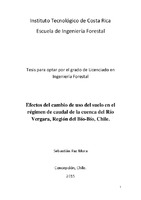Efectos del cambio de uso del suelo en el régimen de caudal de la cuenca del Río Vergara, Región del Bío-Bío, Chile.
Abstract
In recent centuries, humans have transformed much of the planet's surface modeling the landscape. In consequence, he has altered the dynamics of the hydrological cycle. Deforestation, forest fires, increased agriculture, abandonment of crops and urbanization are different variables affecting water regimes. In the south-central Chile the main causes of changes in the landscape have been the opening of agricultural land and the increasing of forestry with exotic species such as Pinus spp. and Eucalyptus spp. which dominate the landscape. In this study the patterns of change in land use were analyzed and how they have affected the flow regime of the Vergara’s river basin located between the Bío - Bío and Araucanía in Chile. A comparison between layers of cover in 1986 and 2011 was performed and a hydrological model N -SPECT about water demand and erosion in the basin was created. The results confirm that the flow and erosion were affected by the transformation of an agricultural landscape to one full of forest, decreasing alike the two variables. It was concluded that the changes on the landscape affect directly the hydrological component in the future.
Description
Proyecto de Graduación (Licenciatura en Ingeniería Forestal) Instituto Tecnológico de Costa Rica, Escuela de Ingeniería Forestal, 2015.


